Kennet and Avon Canal
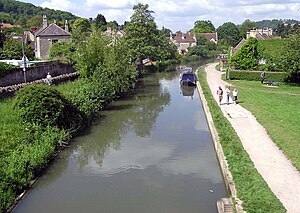
The Kennet and Avon Canal stretches 87 miles overall through Somerset, Wiltshire and Berkshire connecting the River Avon, Somerset with the River Kennet in Berkshire, which latter river is itself navigable to the River Thames (map); thus the Kennet and Avon is a canal provides the link in an inland navigation route from the Bristol Channel in the west to the North Sea in the east.
In the late 19th and early 20th centuries, the canal gradually fell into disuse after the opening of the Great Western Railway. In the latter half of the 20th century the canal was restored in stages, largely by volunteers. After decades of dereliction and much restoration work, it was fully reopened in 1990. The Kennet and Avon Canal has been developed as a popular heritage tourism destination for boating, canoeing, fishing, walking, and cycling, and is also important for wildlife conservation.
Route
The canal is made up of two lengths of navigable river linked by a canal and the name is commonly used to refer to the entire length of the navigation rather than solely to the central canal section. From Bristol to Bath, the waterway follows the natural course of the River Avon. From Bath a dug canal crosses the land to the River Kennet at Newbury in Berkshire, and from Newbury to Reading the Kennet is itself canalised to the River Thames.
The two river stretches were made navigable in the early 18th century, and the 57-mile canal section was constructed between 1794 and 1810.
In all, the canal, including the canalised rivers, incorporates 105 locks.

Bristol to Bath
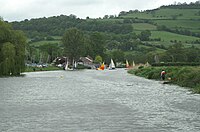
The River Avon was navigable from Bristol to Bath during the early years of the 13th century, until the construction of mills on the river impeded it.[1] The modern Avon is navigable from its mouth at Avonmouth, through the Floating Harbour in Bristol, as far as Pulteney Weir in the centre of Bath, that latter section made navigable by the use of locks and weirs at Hanham, Keynsham, Swineford, Saltford, Kelston and Weston, which together overcome a rise of 30 feet within 12 miles.[2] Lock number one on the Kennet and Avon Canal is Hanham Lock, first opened as part of the Avon Navigation in 1727 and the first lock upstream of the Floating Harbour, beyond the suburbs of the city of Bristol. A colliery wharf was sited just west of the lock, but the nearby coal mines closed in the 19th century.[3] The river below Hanham Lock is considered to be tidal, as high tides often pass over the weir at Netham, though the highest spring tides may pass over the weir at Hanham too, bringing the tidal river up to Keynsham Lock.[4]
The banks of the canalised Avon here have seen factories for whom the canal was a means of distribution. A public house (the Lock Keeper, formerly the White Hart) has been built on the island between Keynsham Lock and the weir. The weir side of the island is also the mouth of the River Chew.[5]
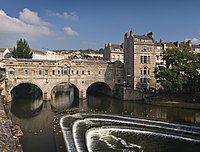
Above the factories of Bristol the Avon has passed by the Avon Valley Country Park and the interesting geology of northern Somerset. Further up at Swineford Lock between 1709 and 1859, there was an active brass and copper industry served by the river, which also provided water power for the cloth industry.[6] The remains of Kelston Brass Mill, which was working until 1925, are next to Saltford Lock. The lock was opened in 1727 but destroyed by rival coal dealers in 1738, to prevent the river's being used for transportation.[6]
The Bristol and Bath Railway Path shadows and crosses the navigation several times before reaching the suburb of Newbridge on the outskirts of Bath. Here is the "Newton St Loe SSSI", which is so designated because it represents the only remaining known exposure of fossiliferous Pleistocene gravels containing the remains of mammoths and horses along the river. The highest lock below Bath is Weston Lock, opened in 1727. Its construction created an island between the cut and the river weir, which became known as Dutch Island after the owner of the brass mill established on the riverside in the early 18th century.[7]
The City of Bath is a delight for the senses though the river can be more workmanlike. As it flows beneath the Pultney Bridge however it adds its beauty to the city, and the weir here is artistically built. This weir is the limit of navigation on the Avon.
Bath to Devizes
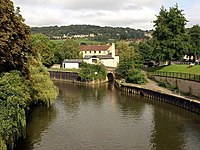
At the Pulney Weir the Kennet and Avon Canal leaves the River Avon, through the Bath Bottom Lock,[8] just south of Pulteney Bridge.
Just upstream of the Bottom Lock are a side pound and a pumping station that pumps water "upstream" of the locks, to replace that used each time a boat passes through.[9][10] The next of the six Bath Locks is Bath Deep Lock, numbered 8/9 as two locks were combined when the canal was restored in 1976.[11] The new chamber has a depth of 19 feet, making it the United Kingdom's second-deepest canal lock.[10] Just above the Deep Lock is another side pound as a reservoir for refilling the lock, followed by Wash House Lock.[12] After a slightly longer pound is Abbey View Lock,[13] beside which there is another pumping station and then, in quick succession, Pultney Lock and Bath Top Lock.[14]
Above the Top Lock the canal passes through Sydney Gardens by two short tunnels[15][16] and under two cast iron footbridges dating from 1800. Cleveland Tunnel is 173 feet long and runs under Cleveland House, the former headquarters of the Kennet and Avon Canal Company[17] and now a Grade II* listed building.[18] A trap-door in the tunnel roof was used to pass paperwork between clerks above and bargees below.[17]
Many of the bridges over the canal are listed buildings:
- "Footbridge Adjoining Top Lock"[19]
- "Footbridge adjoining Wash House Lock"[20]
- "Footbridge over Canal"[21]
- "Canal Bridge"[22]
- "Bridge over Canal"[23]
- "Canal Bridge (Pulteney Gardens)"[24]
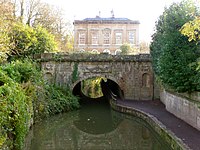
On the eastern outskirts of Bath a toll bridge over the canal near the George Inn links Bathampton to Batheaston, on the north bank of the canal. The canal turns south into a valley between Bathampton Wood and Bathford Hill which includes Brown's Folly a 99-acrebiological and geological Site of Special Scientific Interest.[25]
In the Avon Valley to the east of Bath the classic geographical example of a valley with all four forms of ground transport is found: road, rail, river, canal. The canal passes the remains of a loading dock, once used for Bath Stone from the quarries on Bathampton Down, which was carried down a straight track to the canal over the Dry Arch rock bridge (demolished in 1958 to allow double-decker buses to use the A36).[26] Next, the canal passes the waterwheel-powered Claverton Pumping Station, which pumped water from the River Avon into the canal. The building was completed in 1810 and the pump was working by 1813.[27]
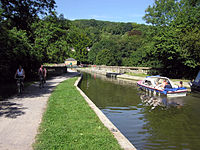
The canal then crosses over the river and the Wessex Main Line railway at the Dundas Aqueduct. At the western end of the Dundas Aqueduct it is joined by the remains of the Somersetshire Coal Canal, a short stretch of which has been restored to create the Brassknocker Basin.[28] Excavations of the old stop lock showed that it was originally a broad 14-foot lock that at some point was narrowed to 7 feet by moving the lock wall.[29] The Somerset Coal Canal was built around 1800 from basins at Paulton and Timsbury, giving access to London from the Somerset Coalfield, which at its peak contained 80 collieries.[30]
At the Dundas Aqueduct, built in 1805, the canal crosses high above the River Avon, the railway line and the county border into Wiltshire at Conkwell Wood.
Further along it recrosses the river and railway at the Avoncliff Aqueduct. After the Avoncliff Aqueduct the canal passes through Barton Farm Country Park, past Gripwood Quarry on its way into Bradford on Avon.
The first sod for the Kennet and Avon Canal was turned in Bradford on Avon in 1794, and soon there were wharves above and below Bradford Lock. Further east, an aqueduct carries the canal over the River Biss.[31] There are locks at Semington and Seend, where water flows into the canal from the Summerham Brook, otherwise known as the Seend Feeder.
In the village of Semington the Wilts & Berks Canal joined the canal, linking the Kennet and Avon to the River Thames at Abingdon. The North Wilts Canal merged with it to become a branch to the Thames and Severn Canal at Latton near Cricklade, but this canal was abandoned in 1914.
Further west the canal approaches the town of Devizes, before which it has to climb Caen Hill.
The Caen Hill Locks
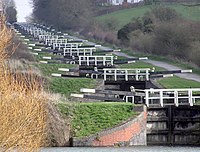
The Caen Hill Locks west of Devizes lift the Kennet and Avon Canal high up the hill to the town. This remarkable flight of locks provides an insight into the engineering needed to build and maintain the canal. The main flight of 16 locks, which take 5–6 hours to navigate in a boat,[32] and is part of a longer series of 29 locks built in three groups: seven at Foxhangers, sixteen at Caen Hill, and six at the town end of the flight.[33][34]
The total rise is 237 feet in 2 miles or a 1 in 30 gradient.[35] The locks were the last part of the 87-mile route of the canal to be completed. The steepness of the terrain meant that there was no space to use the normal arrangement of water pounds between the locks. As a result, the 16 locks utilise unusually large side ponds to store the water needed for their operation.[36] Because a large volume of water is needed a back pump was installed at Foxhangers in 1996, capable of returning 7 million gallons of water a day to the top of the flight, equivalent to one lockful every 11 minutes.[37]
While the locks were under construction in the early 19th century a tramroad provided a link between Foxhangers at the bottom of the flight and Devizes at the top, the remains of which can be seen in the towpath arches in the road bridges over the canal.[37] From 1829 until 1843 the flight,[34] which includes the narrowest lock on the canal, Lock 41,[32] was illuminated by gas lights.[34]
At the top of the flight is Devizes Wharf, home to the Kennet & Avon Canal Museum, which has a range of exhibits on the conception, design, usage, and eventual commercial decline of the Kennet and Avon Canal, as well as its subsequent restoration. It is operated by the Kennet and Avon Canal Trust, which has its headquarters and a shop within the Canal Centre.[38] The Wharf Theatre is in an old warehouse on the same site.[39] Devizes wharf is the starting point for the Devizes to Westminster International Canoe Marathon, which has been held since 1948.[40]
Devizes to Newbury
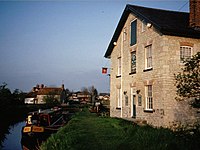
Heading east from Devizes the canal passes through the Wiltshire countryside and a series of locks and swing bridges before another flight of locks at Crofton.
At Honeystreet is the remains of a wharf that was the home of boat builders Robbins, Lane and Pinnegar, which served as the boat building headquarters of the Canal Company.[41] They built many of the boats used on the canals of southern Britain before closing in about 1950. Next to the wharf is the Barge Inn, a substantial public house once known as the George Inn. It was roughly half-way along the canal and served as a bakehouse, slaughterhouse, and shop for provisions for those living and working on the canal. The building was destroyed by fire in 1858 and rebuilt within six months.[42] It was built just within the parish boundary of Stanton St Bernard to "serve the Honey Street wharf in Alton parish, which refused to allow drinking establishments".[43]
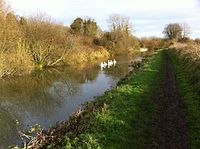
Jones's Mill is a 29-acre area of fen vegetation, scrub, and woodland lying along the headwaters of the Salisbury Avon northeast of Pewsey. It has been designated a biological Site of Special Scientific Interest because it is "the best known example of a calcareous valley mire in Wiltshire".[44]
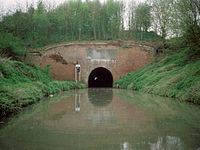
The four locks at Wootton Rivers mark the end of the climb from the Avon. Between Wootton Top Lock and Crofton is the summit pound of the canal at 450 feet above sea level, stretching for about two miles. This stretch and includes the Bruce Tunnel, 502 yards long.[45]
The Bruce Tunnel is named after the local land owner, Thomas Brudenell-Bruce, 1st Earl of Ailesbury (1729–1814), who refused to allow a deep cutting through his property and insisted on a tunnel.[46] The tunnel has red brick portals, capped with Bath Stone, each with a decorative stone plaque of Bristol Pennant Limestone. It was begun in 1806 and finished in 1809. It has a wide bore to cope with the Newbury barges used on the canal.[47] There is no towpath through the tunnel, therefore walkers and cyclists must walk across the top of the hill. When canal boats were pulled by horses the boatmen had to haul their barges through the tunnel by hand, pulling on chains that ran along the inside walls.[48]
The Crofton Locks flight marks the start of the descent from the summit to the Thames; the nine locks have a total rise/fall of 61 feet.[49] When the canal was built there were no reliable water sources available to fill the summit by normal gravitational means. A number of usable springs were found adjacent to the canal route about one mile east of the summit pound, and about 40 feet below it, and arrangements were made for them to feed the pound below lock 60 at Crofton. Some years later the Wilton Water reservoir was created to enhance the supply to this pound using the springs and the River Dun.[50]
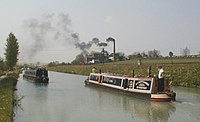
Water is pumped to the summit at the western end of the locks, from Wilton Water, by the restored Crofton Pumping Station. The original steam-powered pumping station is preserved and contains one of the oldest operational Watt-style beam engines in the world, dating from 1812. The steam engines still pump water on selected weekends, but for day-to-day operation electric pumps are used, automatically controlled by the water level in the summit pound.[51][52]
Near Crofton are the Savernake Forest[53] and the remains of a railway bridge that carried the Midland and the South Western Junction Railway over the canal.
Mill Bridge at Great Bedwyn is unusual in being a skew arch; on its completion in 1796 it was the first of its kind.[54] From there to Hungerford the canal follows the valley of the River Dun through Freeman's Marsh, which consists of unimproved meadows, marsh, and reedbed. It is an important site for overwintering, migratory and breeding birds, and supports many varieties of flora scarce in he southern counties. There are plans to construct a marina and hotel complex adjacent to the site, but the potential environmental impacts of such a development on Freeman's Marsh have led to local opposition.[55][56]
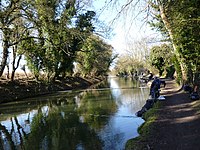
There are several locks and bridges in Hungerford, including one which carries the A338. Hungerford Marsh Lock is unique on the Kennet and Avon Canal in that it has a swing bridge directly over the centre of the lock that must be opened before the lock may be used.[57] In the area around the lock, called Hungerford Marsh Nature Reserve, more than 120 bird species have been recorded.[58]
Between Kintbury Lock and Newbury, passing to the north of Hamstead Marshall, the canal is very close to the River Kennet, which flows into the canal by several channels.[59] The canal passes through an area known as the Kennet Valley Alderwoods, the largest remaining fragments of damp, ash-alder woodland in the River Kennet floodplain.
A wooden bridge was built close to Newbury Lock[60] in 1726, replaced in stone between 1769 and 1772 by James Clarke,[61] and now known as the Town Bridge or Water Bridge. As there is no tow path, a line to haul the barge had to be floated under the bridge and then re-attached to the horse where the tow path resumed.[62]
Newbury to Reading
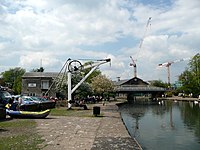
The River Kennet is navigable from Newbury downstream to the confluence with the River Thames at Kennet Mouth, in Reading.[63]
The stretch from Newbury to High Bridge in Reading is an improved river navigation known as the Kennet Navigation, opened in 1723. Throughout this navigation stretches of natural riverbed alternate with 11 miles of artificial lock cuts and a series of locks that overcome a fall of 130 feet.[64]
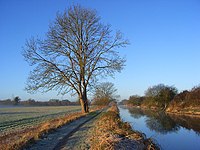
Monkey Marsh Lock at Thatcham is one of only two remaining working examples of turf-sided locks on the canal today.[65] It is listed as a Scheduled Ancient Monument by English Heritage.[66][67]
Below Colthrop Lock in Thatcham the river leaves behind the built-up area of Newbury and runs in generally rural surroundings. It passes through the Woolhampton Reed Bed, a dense reed bed notable for the diversity of insects it supports and its nesting passerine bird populations. Aldermaston Gravel Pits consist of mature flooded gravel workings surrounded by dense fringing vegetation. The surrounding marsh and scrub are important for numerous birds. In 2002, English Nature bought Aldermaston Gravel Pits from the mineral extraction company and it is managed as a nature reserve.
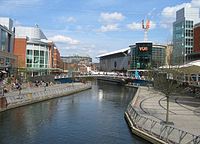
The village of Woolhampton and the canal settlement of Aldermaston Wharf are the only significant settlements until the river enters the built-up area of Reading at Sheffield Lock in Theale. Even after this, the river is isolated from Reading's suburbs by a wide floodplain surrounding the river. In this stretch is Garston Lock, the other turf-sided lock on the navigation.[68]
Shortly after passing Fobney Lock and the associated water treatment works, the Kennet flood plain narrows and the river enters a narrow steep-sided gap in the hills forming the southern flank of the Thames flood plain.[69] At County Lock the river enters the centre of Reading, where it formerly flowed through the centre of a large brewery. This narrow and twisting stretch of the river became known as Brewery Gut. Because of poor visibility and the difficulty of boats passing in this stretch, traffic has long been controlled by a set of maritime traffic lights.[70] Today the Brewery Gut is a major feature of Reading's The Oracle shopping centre.[63]
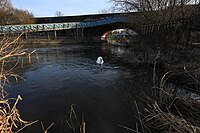
Immediately after The Oracle the river flows under the arched High Bridge. The last mile of the River Kennet in Reading below the bridge has been navigable since at least the 13th century. Because there is no wide floodplain, wharves could be built during the Middle Ages that allowed Reading to establish itself as a river port.[71] Originally this short stretch of river, which includes Blake's Lock, was under the control of Reading Abbey. Today it is administered by the Environment Agency as if it were part of the River Thames.[72][73] The Horseshoe Bridge at Kennet Mouth was built as a railway bridge in 1839, and the timber-clad iron-truss accommodation bridge was added in 1892.[74]
History
Early plans
The idea of an east to west waterway link across southern England was first mentioned in Elizabethan days,[75] to take advantage of the proximity of the rivers Avon and Thames, only three miles apart at their closest. Later, around 1626, Henry Briggs made a survey of the two rivers and noted that the land between them was level and easy to dig and he proposed a canal to connect them, but following Briggs' death in 1630 the plan was dropped. After the Civil War four bills were presented to Parliament, but all failed after opposition from gentry, farmers and traders worried about cheaper water transport reducing the value of fees on turnpike roads they controlled, and cheaper produce undercutting locally produced food.[75] The main alternative to road transport for the carriage of goods between Bristol and London was a hazardous sea route through the English Channel, but the small coastal sailing ships of the day were at risk of Atlantic storms, and were prey for French warships and privateers during a succession of conflicts with France.[1]
Plans for a canal were shelved until the early 18th century. In 1723 the Kennet Navigation through Reading opened. The Avon navigation from Bristol to Bath was opened in 1727; the first cargo of "Deal boards, Pig-Lead and Meal" reached Bath in December.[76] The two navigations were built to meet local needs independently of one another, but both under the supervision of surveyor and engineer John Hore. In 1788 the so-called "Western Canal" was proposed to improve trade and communication links to towns such as Hungerford, Marlborough, Calne, Chippenham and Melksham. The following year the engineers Barns, Simcock and Weston submitted a proposed route for this canal, although there were doubts about the adequacy of the water supply. The name was changed from Western Canal to Kennet and Avon Canal to avoid confusion with the Grand Western Canal, which was being proposed at the same time.[77]
Construction
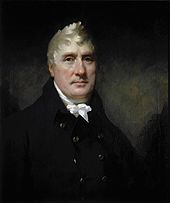
In 1793 a further survey was conducted by John Rennie the Elder, and the route of the canal was altered to take a more southerly course through Great Bedwyn, Devizes, Trowbridge and Newbury. The proposed route was accepted by the Kennet and Avon Canal Company, chaired by Charles Dundas, and the company started to take subscriptions from prospective shareholders. In July 1793 Rennie suggested further alterations to the route, including the construction of a tunnel in the Savernake Forest.[77] On 17 April 1794 the Kennet and Avon Canal Act received the Royal Assent and construction began. The Newbury to Hungerford section was completed in 1798, and was extended to Great Bedwyn in 1799. The section from Bath to Foxhangers was finished in 1804, and the two were linked by an iron railway until the completion of Devizes Locks in 1810.[77]
The canal opened in 1810 after 16 years of construction. Major structures included the Dundas Aqueduct and Avoncliff Aqueduct, the Bruce Tunnel under Savernake Forest, and the pumping stations at Claverton and Crofton, needed to overcome water supply problems. The final engineering task was the completion of the Caen Hill Locks at Devizes.[78]
Operation
In 1801, trade along the canal commenced, even though goods had to be unloaded at Foxhangers at the bottom of what is now Caen Hill Locks, transported up the hill by a horse-drawn railway, and reloaded into barges at the top. When the flight of locks opened in 1810, allowing the same vessel to navigate the entire canal, the rate of carriage per ton from London to Bath was £2 9s 6d, which compared well with carriage by road, which cost £6 3s to £7 per ton, and therefore trade on the canal flourished. In 1812, the Kennet and Avon Canal Company bought the Kennet Navigation, which stretched from Newbury to the junction with the Thames at Kennet Mouth, near Reading. The purchase from Frederick Page cost £100,000, of which £70,000 was paid in cash with the balance paid back over a period of time. The purchase was authorised by the Kennet Navigation Act of June 1813, which enabled the company to raise the funds through the sale of 5,500 shares at £24 each. At the same time work was undertaken to improve the Avon Navigation, from Bristol to Bath, with the Kennet and Avon Canal Company purchasing a majority shareholding in the Avon Navigation in 1816.[79]
By 1818, seventy 60-ton barges were working on the canal, the majority of the tonnage being coal and stone travelling by way of the Somerset Coal Canal.[80] The journey from Bath to Newbury took an average of three and a half days. By 1832, 300,000 tons of freight was being carried each year and, between 1825 and 1834, the company had an annual revenue of around £45,000.[77]
Decline
The opening of the Great Western Railway in 1841 removed much of the canal's traffic, even though the canal company lowered tariffs.[81] In 1852 the railway company took over the canal's operation, levying high tolls at every toll point and reducing the amount spent on maintenance. Ice-breaking was stopped in 1857, and traders were encouraged to use the railway rather than the canal. In 1861 an order prohibited any traffic on the canal at night and in 1865 boats were forced to pass through locks in pairs to reduce water loss. By 1868 the annual tonnage had fallen from 360,610 in 1848 to 210,567. In the 1870s water abstraction from the canal near Fobney Lock followed the regulations introduced in the Reading Local Board Waterworks, Sewerage, Drainage and Improvements Act of 1870, and contributed to the silting up of locks and stretches of the canal. Several wharves and stretches of towpath were closed. In 1877 the canal recorded a deficit of £1,920 and never subsequently made any profit.[82]
The Somerset Coal Canal and Wilts & Berks Canal, which each supplied some of the trade from the Somerset Coalfield to the Kennet and Avon,[83] closed in 1904 and 1906 respectively. In 1926, following a loss of £18,041 the previous year,[84] the Great Western Railway sought to close the canal by obtaining a Ministry of Transport Order, but the move was resisted and the company charged with improving its maintenance of the canal.[81] Cargo trade continued to decline, but a few pleasure boats started to use the canal.[85]
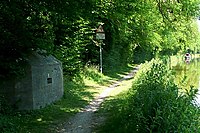
During the Second World War a large number of concrete bunkers known as pillboxes were built as part of the GHQ Line to defend against an expected German invasion, many of which are still visible along the banks of the canal.[86] They were generally built close to road and rail bridges, which would have formed important crossing points for enemy troops and vehicles.[87][88]
After the war the Transport Act of 1947 passed control of the canal to the British Transport Commission, but by the 1950s large sections of the canal had been closed because of poor lock maintenance following a breach in the bank west of the Avoncliff Aqueduct.[77] The last through passage was made in 1951.
Closure avoided
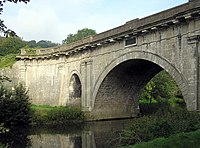
A group supporting the restoration of the canal had been set up in the early 1950s, and later merged with the Inland Waterways Association. In 1955 John Gould, a trader on the eastern section of the waterway, successfully petitioned against the commission's failure to maintain the waterway and obtained damages for loss of business. Parliament attempted to remove the right of navigation between Reading and Bath, which caused great opposition[89] supported by a 22,000-signature petition to the Queen, brought to London from Bristol by water; parts of the canal had to be traversed by canoe.[89] The House of Lords amended the Bill to enforce "no further deterioration". The 1958 Bowes Report into inland waterway found "no justification for restoring the section from Reading to Bath".[90] but a government white paper the next year took the side of regeneration.
The Kennet and Avon Canal Trust, a voluntary group, was formed in 1962 to restore the canal from Reading to Bristol as a through navigation and as a public amenity, and it later gained charitable status In 1963 British Waterways was created to take over the nationalised canals and in partnership with the Trust and local authorities, restoration work began.[91]
Restoration
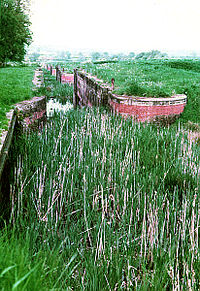
Restoration work has involved collaboration between British Waterways and volunteer labour. In 1966 Sulhamstead Lock was rebuilt and the re-puddling of the dry section at Limpley Stoke began. In 1968, restoration work was undertaken on the Bath Locks and Burghfield Lock. In Reading at Bridge Street a new bridge was built which restored the headroom previously enjoyed by the canal. The canal was reopened from the Thames to Hungerford Wharf in July 1974.
Further work continued through the 1980s, and schemes devised to cope with problems such as leakage, new bridges and the inadequacy of reservoirs to supply water to the canal summit, requiring back-pumping at increased cost: the Wilton Water reservoir was estimated to produce less than 750,000 gallons a day, and the Seend feeder only 250,000 gallons, so the Wessex Water Authority agreed to the extraction of 1,000,000 gallons a day from the Avon at Claverton to be pumped east with new pumps.
In 1983 the Manpower Services Commission found 50 men to send to work on Aldermaston Lock and its adjacent wharf, and Widmead Lock, then to restore the Dundas Aqueduct and other, smaller schemes. Others found work and money to put into the restoration project, replacing lock gates, bridges and other necessary works.
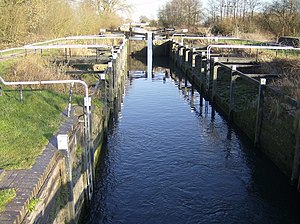
The stretch between Reading and Newbury was completed on 17 July 1990 and at a ceremony held at Monkey Marsh Lock several boats competed to be the first craft through. Concerns about the adequacy of the water supply still remained when Queen Elizabeth II formally reopened the canal on 8 August 1990, but The Queen was able to travel on the Trust's boat Rose of Hungerford through locks 44 and 43 on the Caen Hill flight, breaking a ceremonial tape between them.[92]
The shortage of water was addressed in 1996 by the installation of new back pumps at the flight of 29 locks at Caen Hill at a cost of £1 million. The pumps raise water 235 feet at 300,000 gallons an hour. Upgrading and maintenance continue.
In 2011 the Department for Environment, Food and Rural Affairs designated the canal a national "cruiseway" as defined by the Transport Act 1968. The listing imposes a legal requirement on British Waterways to maintain the canal to a standard that ensures cruising craft can safely navigate the entire length of the waterway.[93] In November 2011 the navigation between Bath and Bristol was closed because of safety concerns about Victoria Bridge in Bath, but traffic now continues as does remedial work to the bridge.[94]
The Canal today
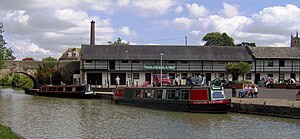
The canal today is a heritage tourism destination. Boating, with narrowboats and cruisers, is a popular tourist attraction particularly in the summer months. Privately owned craft and hire boats from the range of marinas are much in evidence, and there are numerous canoe clubs along its length. The annual Devizes to Westminster International Canoe Marathon starts from Devizes Wharf, the site of the Kennet & Avon Canal Museum, at first light on Good Friday each year and the competitors have to negotiate 75 locks in the 125-mile route between Devizes and the finish at Westminster.[95] The winning time is usually around 17½ hours.[96]
Cycling is permitted along the canal towpath except for a 656-yard section near Woolhampton. Some sections of the canal towpath have been improved and widened to make them more suitable for cyclists and disabled users. Under a partnership arrangement involving British Waterways, Sustrans, and the riparian local authorities, two main sections of the canal have been improved, and, with a few short diversions, run from Reading to Marsh Benham and from Devizes to Bath as part of the National Cycle Network (NCN) Route 4.[97]
Fishing for bream, tench, roach, rudd, perch, gudgeon, pike and carp is permitted throughout the year from the towpath of the canal, but almost its whole length is leased to angling associations or fishing clubs.
There is a variety of riverside public houses, shops and tea rooms. The Kennet and Avon Canal Trust operates shops and tearooms at Aldermaston Lock, Newbury Wharf, Crofton Pumping Station, Devizes, and Bradford on Avon.[98]
References
- ↑ 1.0 1.1 "Kennet & Avon Canal Trust". Kennet and Avon Canal Trust. Archived from the original on 2 April 2012. http://web.archive.org/web/20120402150258/http://home.btconnect.com/kenavon/history_page01.html. Retrieved 20 September 2006.
- ↑ Canalplan - AC Gazeteer
- ↑ Allsop 1987, p. 15
- ↑ Nicholson 2006, p. 60
- ↑ Pearson 2003, p. 8
- ↑ 6.0 6.1 Allsop 1987, p. 17
- ↑ Allsop 1987, p. 20
- ↑ National Heritage List 11250488: Bath Bottom Lock
- ↑ National Heritage List 13172210: Former engine house
- ↑ 10.0 10.1 Allsop 1987, p. 21
- ↑ National Heritage List 13172216: Second Lock
- ↑ National Heritage List 13172211: Wash House Lock
- ↑ National Heritage List 13172214: Abbey View Lock
- ↑ National Heritage List 13172217: Top Lock
- ↑ National Heritage List 11250504: Tunnel under Beckford Road
- ↑ National Heritage List 11250501: Tunnel under Cleveland House and Sydney Road
- ↑ 17.0 17.1 Pearson 2003, p. 13
- ↑ National Heritage List 11250059: Cleveland House
- ↑ National Heritage List 11656609: Footbridge Adjoining Top Lock
- ↑ National Heritage List 13172212: Footbridge adjoining Wash House Lock
- ↑ National Heritage List 11250502: Footbridge over Canal
- ↑ National Heritage List 13324455: Canal Bridge
- ↑ National Heritage List 11250503: Bridge over Canal
- ↑ National Heritage List 13172213: Canal Bridge (Pulteney Gardens)
- ↑ "Brown's Folly". Site of Special Scientific Interest (SSSI). English Nature. http://www.english-nature.org.uk/citation/citation_photo/1002510.pdf. Retrieved 21 July 2011.
- ↑ Thomas 2008, p. 46
- ↑ Hackford 2001, p. 35
- ↑ "Origin of Brassknocker Basin name". Monkton Combe Village. http://www.monktoncombe.com/poap/names/page20.htm. Retrieved 21 November 2007.
- ↑ Halse and Simon 2000, p. 11
- ↑ Clew 1970, pp. 91–95
- ↑ National Monuments Record: No. 865929 – Biss Aqueduct
- ↑ 32.0 32.1 Allsop 1987, p. 27
- ↑ "Seven Wonders of the Waterways". Jim Shead. http://www.jim-shead.com/waterways/Seven-Wonders.html. Retrieved 15 May 2011. ""These seven wonders of the waterways are as listed by Robert Aickman (the co-founder of the Inland Waterways Association in 1946) in his book Know Your Waterways.""
- ↑ 34.0 34.1 34.2 "Caen Hill Locks". Kennet and Avon Scrapbook 2000. University of Portsmouth. http://www.envf.port.ac.uk/kacanal/html/KAC0043.HTM. Retrieved 15 May 2011.
- ↑ Cragg 1997, p. 154
- ↑ "Caen Hill Locks". Waterscape.com. http://canalrivertrust.org.uk/directory/3044/caen-hill-locks. Retrieved 19 February 2013.
- ↑ 37.0 37.1 Pearson 2003, p. 27
- ↑ "Branches". Kennet and Avon Canal Trust. Archived from the original on 11 November 2011. http://web.archive.org/web/20111111145734/http://home.btconnect.com/kenavon/Branches.html. Retrieved 22 July 2011.
- ↑ "About the Theatre". Wharf Theatre. http://www.wharftheatre.co.uk/about. Retrieved 22 July 2011.
- ↑ Brian Greenaway. "The Devizes to Westminster Canoe Race". http://www.dwrace.org.uk/history.html. Retrieved 16 June 2011.
- ↑ National Monuments Record: No. 221270 – Honey Street
- ↑ Russell 1997, pp. 48–49
- ↑ National Heritage List 1365969: Barge Inn
- ↑ "SSSI citation sheet for Jones's Mill" (PDF). English Nature. http://www.english-nature.org.uk/citation/citation_photo/1004402.pdf. Retrieved 15 August 2006.
- ↑ Allsop 1987, p. 35
- ↑ "History & Museum". Kennet and Avon Canal Trust. Archived from the original on 2 April 2012. http://web.archive.org/web/20120402150258/http://home.btconnect.com/kenavon/history_page01.html#alternative%20routes. Retrieved 22 May 2011.
- ↑ "Bruce Tunnel". Kennet and Avon Canal. University of Portsmouth. http://www.envf.port.ac.uk/kacanal/html/KAC0035.HTM. Retrieved 22 May 2011.
- ↑ Clew 1985, p. 203
- ↑ Pearson 2003, p. 37
- ↑ Allsop 1987, p. 36
- ↑ "Outline history". Crofton Pumping Station. http://www.croftonbeamengines.org/page12.html. Retrieved 19 February 2013.
- ↑ "Crofton Pumping Station". Crofton Pumping Station. http://www.crofton.ndo.co.uk/. Retrieved 5 October 2008.
- ↑ Savernake, A History of the County of Wiltshire – Victoria County History
- ↑ Russell 1997, p. 30
- ↑ "Emma Nicholson MEP". Emma Nicholson MEP. Archived from the original on 13 May 2006. http://web.archive.org/web/20060513094154/http://www.emmanicholson.org.uk/south_east.html. Retrieved 22 September 2006.
- ↑ "Planning approval" (MSWord). West Berkshire Council. 2003. http://www.westberks.gov.uk/media/doc/m/g/0301105_1.doc. Retrieved 22 September 2006.
- ↑ Allsop 1987, p. 42
- ↑ "Hungerford Marsh Nature Reserve". Berkshire, Buckinghamshire and Oxfordshire Wildlife Trust. http://www.bbowt.org.uk/reserves/Hungerford-Marsh. Retrieved 6 June 2012.
- ↑ Russell 1997, p. 15
- ↑ National Heritage List 1211989: Newbury Lock
- ↑ National Heritage List 11136850: Bridge over River Kennet
- ↑ Russell 1997, p. 11
- ↑ 63.0 63.1 "River Kennet". Waterways of the UK. http://www.ukcanals.net/waterways-of-the-uk/254-river-kennet. Retrieved 19 February 2013.
- ↑ Pearson 2003, pp. 42–52
- ↑ National Monuments Record: No. 237124 – Monkey Marsh Lock
- ↑ Nicholson 2006, p. 94
- ↑ "Monkey Marsh Lock". Arts and Humanities Data Service. http://ads.ahds.ac.uk/catalogue/search/fr.cfm?rcn=EHNMR-652342. Retrieved 14 June 2009.
- ↑ All change for the K&A: Jim Shead
- ↑ Pearson 2003, p. 52
- ↑ Pearson 2003, p. 53
- ↑ "Kennet & Avon Canal". UK Canals Network. http://www.ukcanals.net/waterways-of-the-uk/153-kennet-a-avon-canal. Retrieved 19 February 2013.
- ↑ "Blake's Lock". River Thames Guide. The River Thames Guide. http://www.riverthames.co.uk/about_thames/3687.htm. Retrieved 17 September 2006.
- ↑ Allsop 1987, p. 49
- ↑ National Monuments Record: No. 1537729
- ↑ 75.0 75.1 Clew 1985, pp. 15–18
- ↑ Allsop 1987, p. 4
- ↑ 77.0 77.1 77.2 77.3 77.4 Russell 1997, pp. 7–10
- ↑ Allsop 1987, p. 5
- ↑ Clew 1985, pp. 79–80
- ↑ Clew 1985, p. 82
- ↑ 81.0 81.1 Lindley-Jones 2002, pp. 9–10
- ↑ Clew 1985, p. 107
- ↑ Hadfield 1967, p. 92
- ↑ Clew 1985, p. 136
- ↑ Clew 1985, p. 140
- ↑ "Defence Area 27 Semington / Whaddon" (PDF). Arts and Humanities Data Service. p. 2. http://ads.ahds.ac.uk/catalogue//adsdata/arch-455-1/dissemination/pdf/Text_Reports/DA27_TEXT_-_SEMINGTON_-_WHADDON.pdf. Retrieved 22 May 2011.
- ↑ "Pillboxes of World War II" (PDF). Bastions of Berkshire. Hungerford Virtual Museum. http://www.hungerfordvirtualmuseum.co.uk/Bastions_of_Berkshire.pdf. Retrieved 12 July 2011.
- ↑ Loaring, Simon; Hunt, David. "An island in the vale". Institute of Historic Building Conservation. http://www.ihbc.org.uk/context_archive/109/island/island.html. Retrieved 12 July 2011.
- ↑ 89.0 89.1 "Kennet & Avon Canal". Inland Waterways Association. http://www.waterways.org.uk/learning/historic_campaigns/kennet___avon_canal. Retrieved 17 May 2011.
- ↑ Clew 1985, p. 156
- ↑ "Kennet & Avon Canal". Kennet and Avon Trade Association. http://www.katrade.org.uk/canal.htm. Retrieved 22 May 2011.
- ↑ Lindley-Jones 2002, pp. 101–102
- ↑ "Kennet & Avon Canal gains 'cruiseway' status". Waterscape. British Waterways. http://www.waterscape.com/features-and-articles/news/3025/kennet-and-avon-canal-gains-cruiseway-status. Retrieved 18 June 2011.
- ↑ "Update: New row over Victoria Bridge as part of river closed to boats". This is Bath. http://www.thisisbath.co.uk/Update-New-row-Victoria-Bridge-river-closed-boats/story-13797253-detail/story.html. Retrieved 17 November 2011.
- ↑ Mileage chart - Devizes to Westminster International Canoe Race
- ↑ Devizes to Westminster International Canoe Race
- ↑ "NCR 4". Sustrans. http://www.sustrans.org.uk/what-we-do/national-cycle-network/route-numbering-system/route-4. Retrieved 15 May 2011.
- ↑ "Useful info" (PDF). Kennet and Avon Canal Trust. p. 5. Archived from the original on 11 November 2011. http://web.archive.org/web/20111111150207/http://home.btconnect.com/kenavon/usefulinfo.pdf. Retrieved 15 May 2011.
- Allsop, Niall (1987). The Kennet & Avon Canal. Bath, UK: Millstream Books. ISBN 978-0-948975-15-8.
- Clew, Kenneth R. (1970). The Somersetshire Coal Canal and Railways. Newton Abbot, UK: David & Charles. ISBN 978-0-7153-4792-8.
- Clew, Kenneth R. (1985). The Kennet & Avon Canal. Newton Abbot, UK: David & Charles. ISBN 0-7153-8656-5.
- Cragg, Roger (1997). Civil Engineering Heritage: Wales and West Central England. London, UK: Thomas Telford. ISBN 978-0-7277-2576-9.
- Green, Ian (2000). Myles, Sarah. ed. The Flora of the Bristol Region. Wildlife of the Bristol Region. Newbury, UK: Pisces Publications. ISBN 978-1-874357-18-6.
- Hackford, Clive (2001). The Kennet & Avon Canal. Stroud, UK: Tempus. ISBN 978-0-7524-2129-2.
- Hadfield, Charles (1967). The Canals of South West England. Newton Abbot, UK: David & Charles.
- Halse, Roger; Castens, Simon (2000). The Somersetshire Coal Canal: A Pictorial Journey. Bath, UK: Millstream Books. ISBN 978-0-948975-58-5.
- Haslam, Sylvia Mary (1987). River plants of western Europe: the macrophytic vegetation of watercourses of the European Economic Community. Cambridge, UK: CUP archive. ISBN 978-0-521-26427-3. http://books.google.com/?id=4vg8AAAAIAAJ&pg=PA410&lpg=PA410&dq=Kennet+and+Avon+Canal+Phragmites+australis#v=onepage&q&f=false.
- Lindley-Jones, Peter (2002). Restoring the Kennet & Avon Canal. Stroud, UK: Tempus. ISBN 978-0-7524-2387-6.
- Nicholson (2006). Nicholson Guides Vol 7:River Thames and the Southern Waterways. London, UK: Collins. ISBN 978-0-00-721115-9.
- Pearson, Michael (2003). Kennet & Avon Middle Thames:Pearson's Canal Companion. Rugby, UK: Central Waterways Supplies. ISBN 0-907864-97-X.
- Russell, John (1997). The Kennet & Avon Canal: A journey from Newbury to Bath in 1964. Bath, UK: Millstream Books. ISBN 978-0-948975-46-2.
- Thomas, Rod (2008). A Sacred landscape: The prehistory of Bathampton Down. Bath, UK: Millstream Books. ISBN 978-0-948975-86-8.
- Vile, Nigel (1991). Exploring the Kennet & Avon Canal. Newbury, UK: Countryside Books. ISBN 978-1-85306-124-0.
- Youe, Michael; Tate, John (1998). "British Waterways: a study in the search for sustainability". Sustainable Development (John Wiley & Sons, Ltd) 6 (2): 68–77. doi:10.1002/(SICI)1099-1719(199808)6:2<68::AID-SD86>3.0.CO;2-D. http://www3.interscience.wiley.com/journal/10006448/.
Outside links
| ("Wikimedia Commons" has material about Kennet and Avon Canal) |
- Route map
- The Kennet and Avon Canal trust
- National Cycle Route 4
- Visit K&A – Kennet & Avon Canal Rural Transport Partnership
- Kennet & Avon Trade Association
